9 Ways to Remove Unused, Old or Hidden Drivers
6. Device Cleanup Tool
The Device Cleanup Tool is a nice and simple program by Uwe Sieber that detects devices that are not currently in use and allows you to remove them. It does this by checking the device for the “Currently, this hardware device is not connected to the computer. (Code 45)” status code. Device Cleanup Tool is portable with separate 32-bit and 64-bit versions, make sure to use the right one.
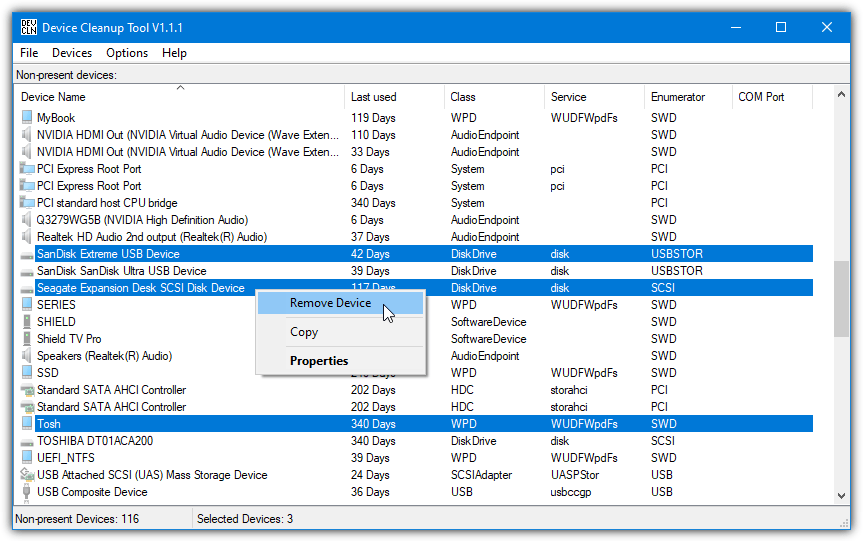
Deleting devices can be done on an individual basis by clicking each device, right clicking, and choosing Remove Device. Multiple devices can be selected with Shift+click or Ctrl+click. If you’re unsure about the device, either leave it or go to the File menu and create a restore point first. The Select all option is definitely not recommended unless you are totally sure all devices can be removed safely.
The last used column should display the last time the device was in use but sometimes just displays the last time it was enumerated on boot, so is not always accurate.
7. Device Cleanup Tool Command Line Version
This is the command line version of Device Cleanup Tool which will come in useful for advanced users deleting devices from batch files and scripts. It only allows you to delete plug and play devices that are listed as not connected.
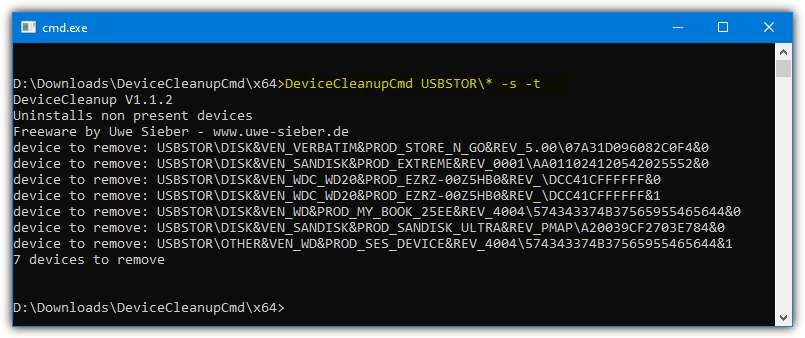
There are three main ways to remove devices using the command line Device Cleanup Tool. Mass deletion of all devices at once, delete devices that haven’t been used for xx number of days/months/years, or delete by hardware device ID ( * wildcard pattern accepted). A few examples are:
DeviceCleanupCmd * (Remove all devices, advanced users only!)
DeviceCleanupCmd * -m:3m (Remove all devices unused for more than 3 months)
DeviceCleanupCmd HID\vid_* (Remove unused HID devices, usually keyboards, mice, joysticks etc)
DeviceCleanupCmd USBSTOR\* (Remove USB storage devices that are not connected)
A couple of optional arguments are -s to bypass creating a restore point, and -t to test the command only. Hardware IDs are found in the Details tab in the Properties window for the device in Device Manager. Make sure to use the correct 32-bit or 64-bit version for your system.
Download Device Cleanup Tool Command Line
8. DriveCleanup
This is the third tool in our list by Uwe Sieber and unlike above, it’s not a general command line remover for non present devices. Instead, DriveCleanup specifically removes unused USB Hubs, Mass Storage Devices, Disks, CDROMs, Floppies, Storage Volumes, and Windows Portable Devices. It also cleans the registry and removes entries related to those devices.
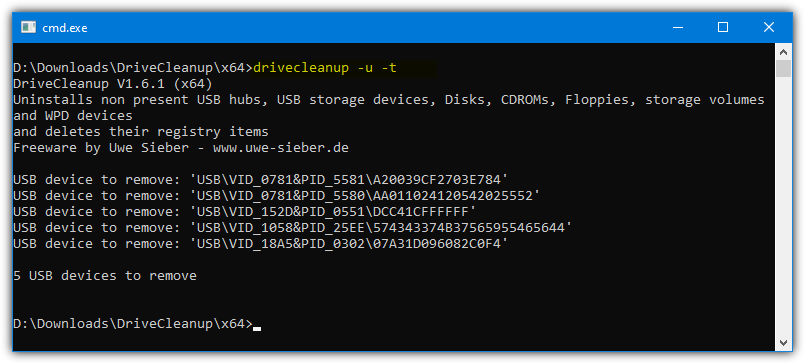
The tool will automatically run the delete and clean when you double click on its icon, so be careful if that’s not what you want. Running from the command line you can supply the -t argument to run a test only.
A number of switches are available if you want to remove specific device types. For example, -f and -c will remove only floppy and CDROM devices, -u will only remove USB mass storage devices. Check the included readme file for the other arguments. Like the other two tools here by Uwe Sieber, run the 32-bit or 64-bit version that matches your system.
9. Remove Hidden Devices With Windows Device Manager
The built in Windows driver and device management tool, Device Manager, is also able to show and remove hidden devices from the system. It has an added ability the other tools don’t (apart from DDU) which is an option in some cases to delete old or redundant files related to the driver you are removing. The main problem with using Device Manager for this task is it’s not easy to delete multiple devices at once.
Before viewing and editing hidden devices in Device Manager, your system needs to be told to show them. This doesn’t happen by default and a new environment variable needs to be added to Windows first.
1. Right click on the Computer/This PC desktop icon > Properties > Advanced system settings, click the Environment Variables button. Alternatively, press Win/Start, type env into search, and press Enter.
2. Press the upper New button. Enter DEVMGR_SHOW_NONPRESENT_DEVICES as the variable name and 1 as the variable value. Press OK twice.
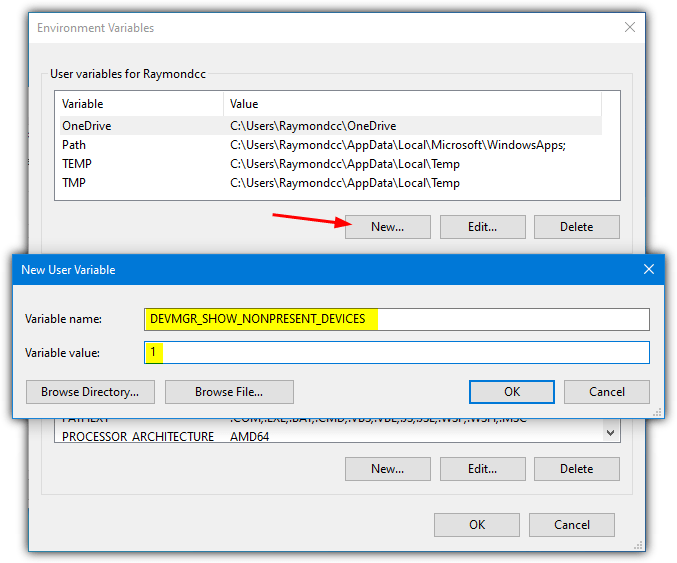
3. Now start Device Manager by right clicking Computer/This PC > Properties > Device Manager. Or type devmgmt.msc into Start or the Run dialog. For convenience, we have created a small batch file that will add the environment variable to the system and run Device Manager automatically. Simply download Set DEVMGR SHOW NONPRESENT DEVICES.bat and double click it.
4. In Device Manager go to the View menu and select Show hidden devices. This will repopulate the main window with a number of extra categories like Digital Media Devices, Non plug and play drivers, Other devices, and storage volume shadow copies.
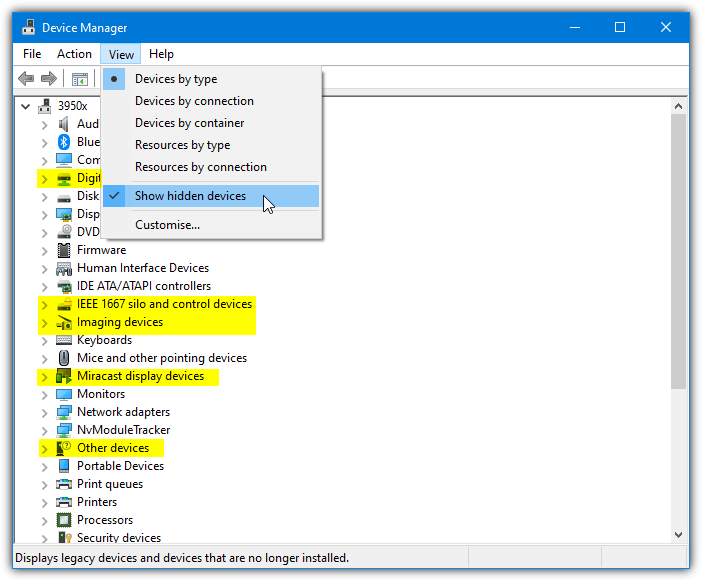
5. Now all hidden devices are visible you can go through the categories and look for devices you don’t want. The devices that are not in use will have dimmed icons, simply right click on one and select Uninstall to remove the entry.
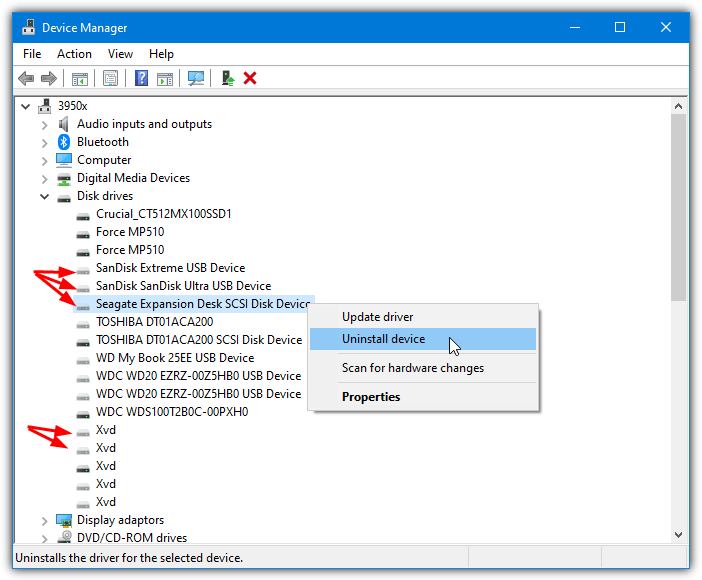
Some third party devices such as graphics cards, sound cards, printers, etc, might have an extra option in the uninstall confirmation box. This is a “Delete the driver software for this device” check box. Using it will remove driver files connected with the device in addition to the registry entry.
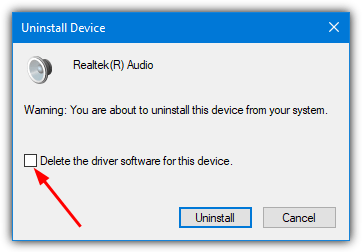
If ever you reconnect the device you will likely have to manually reinstall the driver for it. This is a handy option if you want to clean install a different driver later on or you want to uninstall a driver for troubleshooting.
Editor’s Note: Some devices are hidden by Windows and are meant to be hidden. A number of examples are usually in Network connections, Sound devices, System, and Non plug and play. It is recommended you DO NOT automatically select all hidden devices for deletion in any of the above programs. If you are not experienced or sure, only delete the blatantly obvious entries like an old USB storage device or game controllers.
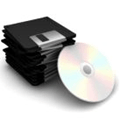
I need to display WHOLE STRUCTURES of the DISCONNECTED devices, e.g.:
An [USB removable] = USB Storage Device + Portable Device + Disk, VOLUMES and their shadow copies (like non-USB HDDs plugged to IDE/SATA)!
Select unsued DISKS (drives), but delete their “parents” and theirs structures!
An [USB Composite Device] = USB Input Device + some HID-compliant (*controller*) devices + HID-compliant Mouse + Keyboard, etc.
Select an unused mouse — delete its parent and all its structure (including keyboard, HID-compliant etc.)
Windows® Device Manager displays structure only for connected (plugged-in) devices: View – Devices by connection :(
Use PnPUtil in an elevated command prompt. It will save you loads of time, money and frustration. I don’t know why this isn’t common knowledge.
See more here ==>docs.microsoft.com/en-us/windows-hardware/drivers/devtest/pnputil-command-syntax
Best advice I have seen in 40 years with regard to checking driver information and usage. Thank you OmniCacciatore!
8 ways? It’s only 1 way. Buy/download 8 different programs… they all just do the same things.
Of course they all do the same things, it’s an article about removing device drivers.
And no, you don’t “buy” any of these programs.
There are 7 third party tools and a built-in option through Windows, so we called it 8 ways, nothing wrong with that, there’s only so many characters to use in a title…
she’s right though. 1 way using 3rd party tools and 1 way using native tools.
I think you’re both entitled to your opinions but they are just that, opinions. There is no definitive “wrong” or “right” way, and I will continue to do it this way when I think it’s needed.
Like I said, there are only so many characters to put in a title, and doing it similar to your way would add another 40+ characters, not wise when a title should be using no more than 60-70 in total anyway.
Solved
Big thank you guys “7. Remove Hidden Devices With Windows Device Manager”
is worked for me
Aren’t there some registry entries that have to be cleaned off the registry? I think so, but I don’t see any discussion about that part of the cleaning process.
It’s mentioned a couple of times about removing registry entries, but yes, they all remove registry entries as that’s how you get rid of the leftovers.
I’m a big fan of #5. I use it in my shop as part of my automated setup and have it remove any devices the system hasn’t seen in over 60 days.
Extremely efficient and effective powerful utilitiy – it is intutitive and was able to remove 4 years of flotsam & jetsam and as noted above if by chance you do remove something relevant Windows will reinstall. I liked the process of considering each item to remove not to remove. Congrats for a great utility!
USBDeview is more to my liking. I had over a hundred ghosts and It was a pain to select all the ghosts (except a few which i will be using later on) for removal. But yes it does a little extra by showing us the ghosted services too. But It isn’t my cup of tea.
Thanks Ray! Appreciate your work, as always!.
My Computer (Win7U) shows my C drive and my F drive, an external HDD and my DVD drive, all which are connected… but also shows THREE Removeable Devices and a CD Drive that are NOT connected and when clicked on, ask that a disk be inserted…. these, I suppose, are “ghost” devices left over in My Computer after removing the devices, (USB drives and external CD Drive connected from time to time)… So then can Ghostbuster remove those entries from My Computer if/when I run Ghostbuster? Thanks for all of your significant work.
@ olamoree: It won’t do any harm if you run Ghostbuster and have a look under ‘DVD/CD-Rom Drives’ and ‘Portable Devices’ to see what entries are listed there. The portable devices section will probably have quite a few entries with phones, mp3 players etc. If you recognize the device or drive letter it uses, add that device only, make sure nothing else is selected for removal and try it. The worst that can happen is the device will be re-detected when you reboot.
hal9000, thanks for the work you have put in thus far . . . much appreciated.
TR
This will be very useful with Windows 8 has Device Manager no longer shows Non-Plug and Play Drivers or hidden devices. The “Devmgr_Show_NonPresent_Devices=1′ environment variable has no effect.
“An option that would be useful is being able to select entries individually or by description. As an example, I have 94 ghost devices (yes 94) listed in ‘Disk Drives’. Many of these are redundant and will never be used again, but a lot will so I don’t want to remove those. Currently adding by class will enable all of them as will adding by device or wildcard.”
I’ve used shift and/or Ctrl to select a group or individual devices after highlighting the first one with a left-click, as is common in other programs and then “added” them all with the right-click menu and removed. Is this what you mean? Don’t seem to be able to do this in device manager, which is really useful for disposing of a whole raft of stuff put there by MS Security Essentials, which I removed from one machine, after having trouble with it after an update. Also (as I have suggested on their site) it would be nice to be able to order the devices by clicking on the top of the columns, thereby putting the ghosted devices together, rather than have to scroll down to find them.
@ Dave: I think my point sort of falls inbetween your request to the developer of sorting by column or being able to right click and add by description. Ctrl+click will select individually but it’s a bit of a pain doing it to nearly 100 devices as they can not be sorted to be able to use Shift+click effectively. You cannot ‘Add’ the selection using right click, only class or device, unless you are using a different version???
On a side note, tried this out on my 4.5 year old highly abused XP partition, and after cutting the total devices from ~600 down to ~250 the difference in boot and general performance was actually quite noticeable!
I liked the use of Ghostbuster, but more, elaborative do’s don’t is required.
After use I may write more confidently, it’s pre-download, comment, Thanks.
USBDeview by NirSoft does a similar job and they have several other good freeware tools
nirsoft.net/utils/usb_devices_view.html